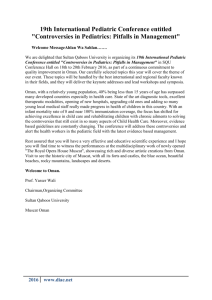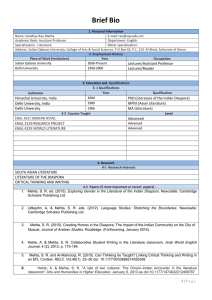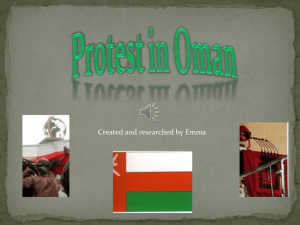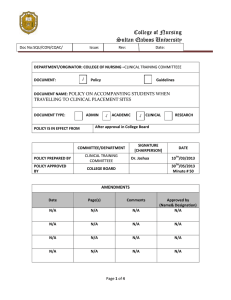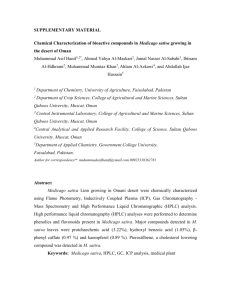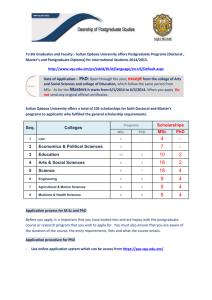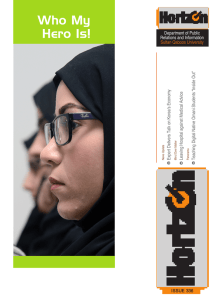Dear Dr
advertisement
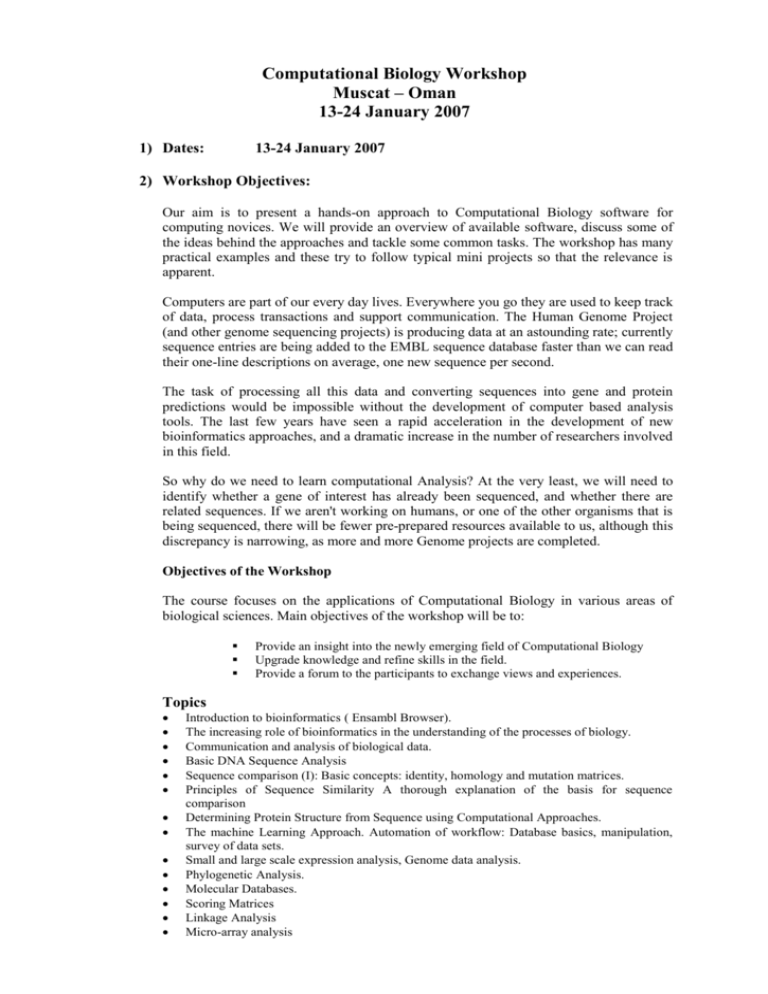
Computational Biology Workshop Muscat – Oman 13-24 January 2007 1) Dates: 13-24 January 2007 2) Workshop Objectives: Our aim is to present a hands-on approach to Computational Biology software for computing novices. We will provide an overview of available software, discuss some of the ideas behind the approaches and tackle some common tasks. The workshop has many practical examples and these try to follow typical mini projects so that the relevance is apparent. Computers are part of our every day lives. Everywhere you go they are used to keep track of data, process transactions and support communication. The Human Genome Project (and other genome sequencing projects) is producing data at an astounding rate; currently sequence entries are being added to the EMBL sequence database faster than we can read their one-line descriptions on average, one new sequence per second. The task of processing all this data and converting sequences into gene and protein predictions would be impossible without the development of computer based analysis tools. The last few years have seen a rapid acceleration in the development of new bioinformatics approaches, and a dramatic increase in the number of researchers involved in this field. So why do we need to learn computational Analysis? At the very least, we will need to identify whether a gene of interest has already been sequenced, and whether there are related sequences. If we aren't working on humans, or one of the other organisms that is being sequenced, there will be fewer pre-prepared resources available to us, although this discrepancy is narrowing, as more and more Genome projects are completed. Objectives of the Workshop The course focuses on the applications of Computational Biology in various areas of biological sciences. Main objectives of the workshop will be to: Provide an insight into the newly emerging field of Computational Biology Upgrade knowledge and refine skills in the field. Provide a forum to the participants to exchange views and experiences. Topics Introduction to bioinformatics ( Ensambl Browser). The increasing role of bioinformatics in the understanding of the processes of biology. Communication and analysis of biological data. Basic DNA Sequence Analysis Sequence comparison (I): Basic concepts: identity, homology and mutation matrices. Principles of Sequence Similarity A thorough explanation of the basis for sequence comparison Determining Protein Structure from Sequence using Computational Approaches. The machine Learning Approach. Automation of workflow: Database basics, manipulation, survey of data sets. Small and large scale expression analysis, Genome data analysis. Phylogenetic Analysis. Molecular Databases. Scoring Matrices Linkage Analysis Micro-array analysis 3) Sponsors The Conference of Islamic Countries (COMSTECH) and Sultan Qaboos University, Muscat, Oman. 4) Candidates: Total 30 [ Software Developers and Software Users] Mathematicians, Statisticians, Computer Science Candidates, Software Developers, Biologists, Geneticists and Physicians from Islamic Countries. Level of experience preferred: Masters or Doctoral Degrees. Evidence of involvement in research in Computational Biology or related fields must be provided. 5) Organization : Professor Riad Bayoumi, Department of Biochemistry, College of Medicine & Health Sciences, Sultan Qaboos University, Muscat, Oman. 6) Travel and Accommodation: Candidates from Islamic Countries selected for the course will receive a travel grant from the Conference of Islamic Countries (COMSTECH) to cover cost of travel from home countries to Oman and back. Free accommodation will be provided at Sultan Qaboos University Faculty Club, for the duration of the workshop 12-25th January 2007. 7) Course venue Annex Building Computer Facility. College of Medicine & Health Sciences, Sultan Qaboos University, Muscat, Oman. 8) Program I- Ensembl : [The genome Browser} BioMart: [Data Mining Tool] API: [Developers kit for customizing Ensembl] This will last for 2½ days. Developers and users will use separate rooms. The users will do Ensembl while Developers will do BioMart and API. II- Phylogeny: A 2½ day session, in which the 2 groups will also split and work separately. Software such as TOPALI will be used. III- Linkage Analysis: A 2½ day session in which biologists and Software developers work together in pairs. IV- Micro-arrays: A 2½ day session in which candidates also work in pairs (Developers and users). Expression profiles and other statistical packages for micro array analysis will be used. Pathway and network analysis is included. 9) Tutors 1) 2) 3) 4) 5) 6) 10) Professor Riad Bayoumi , Sultan Qaboos University, Oman Mr. David Judge, Department of Genetics, University of Cambridge, UK Dr. Lisa Mullan, European Bioinformatics Institute, Cambridge, UK Mr. Frank Dudbridge, MRC Biostatics Unit, Cambridge University, UK Mr. Joaquin Dopazo, University of Cambridge, UK Mr. Xose Fernandes, University of Cambridge, UK Registration Registration is needed (Use Attached Form). Please also send a CV and supporting evidence of involvement in research, to Professor Riad Bayoumi Department of Biochemistry College of Medicine & Health Sciences Sultan Qaboos University P.O.Box: 35, Al Khod, Postal Code 123. Muscat, Sultanate of Oman Phone No: 00968-24141113 Fax : 00968-24413880 E-mail: bayoumi@squ.edu.om and taruna@squ.edu.om (Secretary) 11) Candidate Selection Registration Forms, CVs and supporting evidence have to be returned before 15th September 2006. Candidates will be selected and informed by 15th October 2006. Visa requirements and travel arrangements will be communicated to successful candidates by 1st November 2006. REGISTRATION FORM Computational Biology Workshop 13-24 January 2007 Professor Riad Bayoumi, Sultan Qaboos University P.O.Box: 35, Al Khod, Postal Code 123.Muscat, Sultanate of Oman Tel: 00968-24141113, Fax: 00968-24413880 E-mail: bayoumi@squ.edu.om and taruna@squ.edu.om To be returned by 15th September 2006. Mrs. Mr. Surname: …………………………………………………… First Name: ………………………………………………… Profession: ……………………………………………………………………………. Mailing address: Private Professional Professional Address: ………………………………………………………………. ……………………………………………………………….. Post Code/ City:……………………………………………….. Phone: ………………………… Fax: ………………………….. E-mail: ………………………………………… Private Address: …………………………………………………… ……………………………………………………….. Post Code/ City: …………………………………………………….. Phone: …………………………Fax: ………………………….. E-mail: ………………………………………… Signature ……………………………… Date and Place: ……………………………

